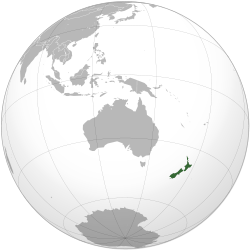
The following outline is provided as an overview of and topical guide to New Zealand:
Contents
- General reference
- Geography of New Zealand
- Environment of New Zealand
- Political geography of New Zealand
- Demography of New Zealand
- Government and politics of New Zealand
- Branches of the government of New Zealand
- Foreign relations of New Zealand
- International organisation membership
- Law and order in New Zealand
- Military of New Zealand
- Local government in New Zealand
- History of New Zealand
- Culture of New Zealand
- Art in New Zealand
- Sports in New Zealand
- Economy and infrastructure of New Zealand
- Education in New Zealand
- See also
- References
- External links
New Zealand is an island country located in the western South Pacific Ocean comprising two large islands, the North Island and the South Island, and numerous smaller islands, most notably Stewart Island / Rakiura and the Chatham Islands. [1] The indigenous Māori originally called the North Island Aotearoa , commonly translated into English as "The Land of the Long White Cloud"; Aotearoa is now used as the Māori language name for the entire country. [2]
New Zealand is situated about 2,000 km (1,200 mi) southeast of Australia across the Tasman Sea, its closest neighbours to the north being New Caledonia, Fiji and Tonga. Because of its remoteness, it was one of the last lands to be settled by humans. During its long period of isolation, New Zealand developed a distinct biodiversity of animal, fungal and plant life. The country's varied topography and its sharp mountain peaks, such as the Southern Alps, owe much to the tectonic uplift of land and volcanic eruptions. New Zealand's capital city is Wellington, while its most populous city is Auckland.
The population is mostly of European descent, with the indigenous Māori being the largest minority. Asians and non-Māori Pasifika peoples are also significant minorities, especially in the cities. Charles III, as the king of New Zealand, is the head of state and, in his absence, is represented by a non-partisan governor-general. Political power is held by the democratically elected New Zealand Parliament under the leadership of the prime minister, who is the head of government. The Realm of New Zealand also includes the Cook Islands and Niue, which are self-governing but in free association; Tokelau; and the Ross Dependency (New Zealand's territorial claim in Antarctica).





